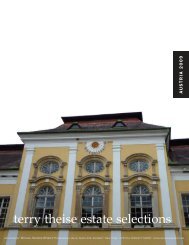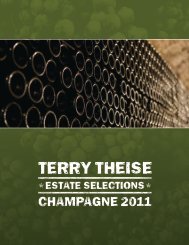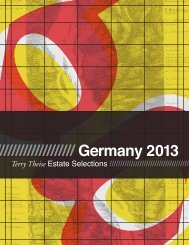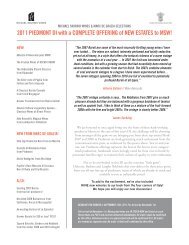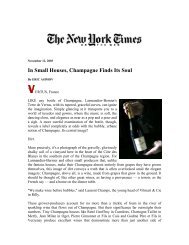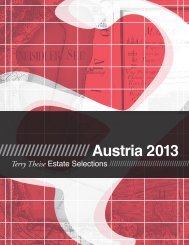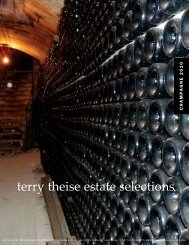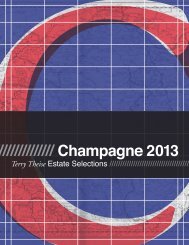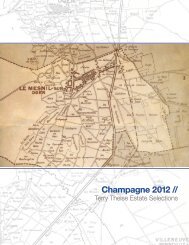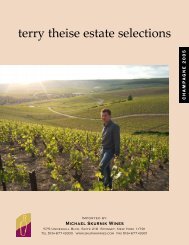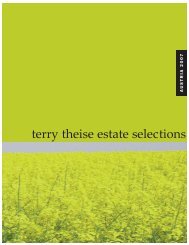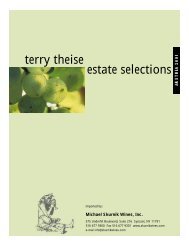German Catalog 2006 USE THIS ONE.qxp - Michael Skurnik Wines
German Catalog 2006 USE THIS ONE.qxp - Michael Skurnik Wines
German Catalog 2006 USE THIS ONE.qxp - Michael Skurnik Wines
You also want an ePaper? Increase the reach of your titles
YUMPU automatically turns print PDFs into web optimized ePapers that Google loves.
RHEINHESSEN WINES<br />
136<br />
christian-wilhelm bernhard<br />
rheinhessen • frei-laubersheim<br />
I’d grown so accustomed to thinking of Hartmut Bernhard as a young pup I was taken aback to<br />
see a little gray starting around his temples. There’s a photo-essay on the wall in the tasting room<br />
showing the 1980 harvest, and Hartmut looks all of eleven years old. Maybe that’s why. My fault,<br />
though, for these wines and this winery are striding forward each year, and no-longer-<br />
”young”—Hartmut Bernhard is entering his prime.<br />
2002 marked the end of the fiberglass and cement tank era in his cellars: all stainless steel<br />
and old casks now.<br />
Bernhard seems to take another step forward each year. If you’re a musician you go through<br />
a period when you’re basically grappling with your instrument. It usually sounds good enough,<br />
but attentive listeners can tell you’re straining. Then, if<br />
you’re good (and lucky), a day comes when the instrument<br />
begins to obey you, and if you’re really good it will<br />
obey you before you’re aware of having commanded it.<br />
Now all you hear is music. Hartmut is nearing that stage<br />
of secure command over his craft; you feel it in the wines.<br />
The Bernhards are out of the way, just over the hill<br />
from Bad Kreuznach and the Nahe Valley. It’s one of<br />
those curious little corners of <strong>German</strong>y. The soils are not<br />
unlike Nahe soils; igneous weathered rock, even porphyry<br />
in some places. Others are typically Rheinhessen<br />
clay; a hybrid of styles emerges. Some wines show Nahelike<br />
skeins of curranty delineation and do best in damper<br />
years. Others are typical Rheinhessen but with a more<br />
compact profile, as though their proximity to the Nahe<br />
caused them to speak with a Nahe-accent. They’re also<br />
lighter and more buoyant than many Rheinhessen wines.<br />
Hartmut’s a shy man, but his wife is hearty and gregarious,<br />
plus she’s a trained vintner from a Mosel family.<br />
These are exceptionally warm, loving people, and we<br />
have a keen, almost telepathic rapport as tasters.<br />
•Vineyard area: 10.9 hectares<br />
•Annual production: 6,000 cases<br />
•Top sites: Hackenheimer Kirchberg, Frei-<br />
Laubersheimer Fels<br />
•Soil types: Porphyry, weathered volcanic<br />
soils, clay and sandy loam<br />
•Grape varieties: 25% Riesling, 21% Spätburgunder,<br />
11% Silvaner, 6% Grauburgunder,<br />
5% Auxerrois, 3% Scheurebe, 3% Gewürztraminer,<br />
22% other varieties<br />
I do wish, though, that I could persuade Hartmut to<br />
give me his Riesling from the porphyry vineyards with<br />
residual sugar; they need it, I want it, but I can’t get it.<br />
Why? His private customers expect it Trocken!<br />
Happily, since the 1999 vintage all Rieslings have<br />
had only Riesling dosage. I’m sure this contributes to<br />
their ever-increasing polish.<br />
Bernhards make a bigger deal out of my visits than<br />
my meager talents warrant. I’m sure they know I like<br />
their wines, but I hope they know I respect them too.<br />
Hoping they’re reading these words; gentlemen (and<br />
lady), it remains a pleasure to grow in the knowledge of<br />
our respective crafts together over the years we’ve<br />
known one another. And it is a joy to know you all.<br />
There. It’s just the sort of thing I can’t say out loud without<br />
dying of embarrasment. Now go away, I’m blushing<br />
as it is.



